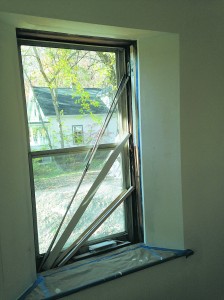A Few More Thoughts About …
Windows in Double Wall Construction
By Michael Goetinck

12 inch deep wall assembly with flared openings. The windows were already installed flush with the exterior.
A reader sent me an email about a window condensation problem he has in his home. I’ve taken the liberty of sharing our correspondence. The text from his email is in italics. My response follows.
Your article on Deep Energy Retrofit Windows in the Feb. 15 issue of Green Energy Times was of interest to me as it was the first time I had seen anything written about where to best place a window in a double-style wall. What I found missing in the discussion was the humidity/condensation aspect of placement. I have R-40 walls, 16″ thick, and not being very savvy then, when my house was built, I agreed to the windows being mounted flush with the exterior of the walls. This was not a good choice as in my tight house (45-50% humidity) the double and triple pane windows (Inline – fiberglass frames) will get wet and even have frost on them near the bottom (below 20 degrees outside). This is mostly due to their deep placement and the resultant difficulty of heating them from the room’s heat because the convection flow is constrained. As many windows have a high temperature source of heat beneath them in the form of baseboard heating, this is less of a problem than my case, low temperature floor heating. How to solve my problem? I’m thinking a low flow battery powered air fan in each window or maybe several ceiling fans – not an elegant solution but cheaper than having the windows reset to a better position within the wall.
As you imply, one of the additional benefits of placing the windows in the middle portion of the wall assembly is that it is closer to the interior conditioned air. I also think that having flared window openings on the interior is important because the window units are not as removed from the interior conditioned air as it moves around the house. Essentially a larger opening is created which allows more warm air to come into contact with the interior side of the window unit. The air undulates into the window openings instead of having to turn corners.
That being said, I have two small windows in my basement that are in rectangular openings as opposed to flared ones and they don’t experience any condensation or frost. I suspect that both the location of the window units in the wall assembly and interior relative humidity levels are contributing to the condensation problem at your place. Is there any way for you to reduce the relative humidity (RH)? Also, there are fans available that can be set on the wood stove which do a very effective job of increasing air circulation. Here’s a link to the one I’ve used in the past: www.caframo.com/hearth/hearth_products_woodstove.php. The only reason I’m still not using it is because it got knocked over at some point and it is no longer quiet.
I’d appreciate hearing back from you to know if lowering the RH or using a fan improves things for you.
Enjoy, Michael
Windows and doors are the weak link in thermal performance (assuming everything else is done correctly). Maybe someday this won’t be the case, but for now; no matter what you do they will not perform as well as a high performance wall assembly. Placement, air circulation, and interior moisture management have to be part of the plan. Heat recovery ventilators (HRVs) can help with indoor air quality and moisture management. Relative humidity levels in the 40-50% range are typically recommended for comfort and building durability, but it may need to be lower to rectify the concern raised by the reader. For what it’s worth, my house typically runs at 20-30% and we’re very comfortable.
Interior relative humidity is an important consideration in any building and even more so in the context of high performance/super insulated ones. Condensation on the windows is annoying, but resulting problems are visible and usually easily managed. Condensation in the wall and roof assemblies is annoying at best and damaging to the building and inhabitants at worst. I’ll talk about that in another article.
Michael Goetinck is the owner of Snowdog Construction, Ltd, in Norwich, VT. This series will continue in Green Energy Times, where the author will cover other topics that can help achieve the deep energy measures which help buildings’ energy performance, and so can benefit us all.








Leave a Reply